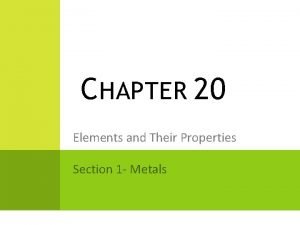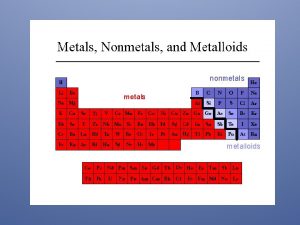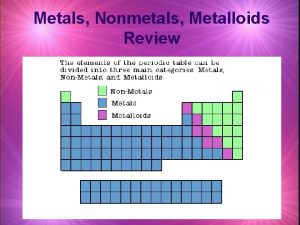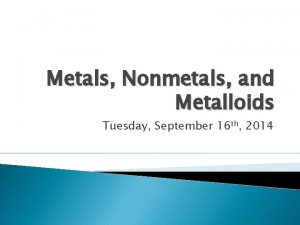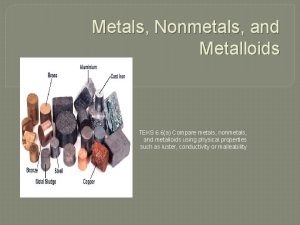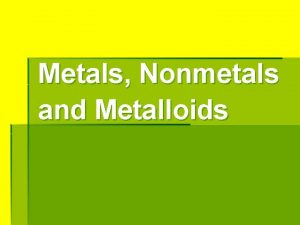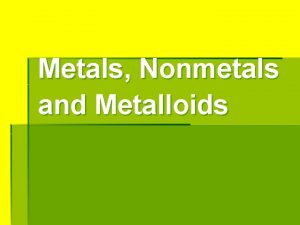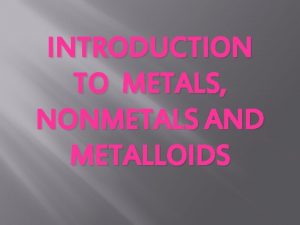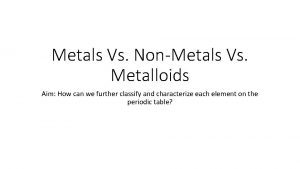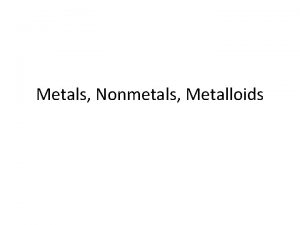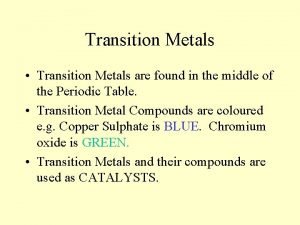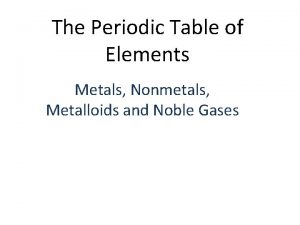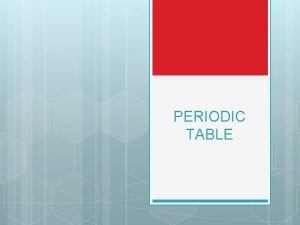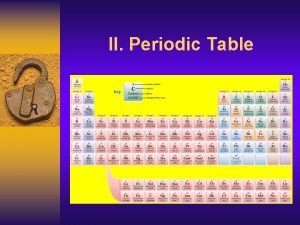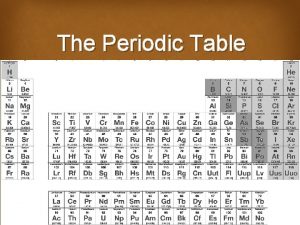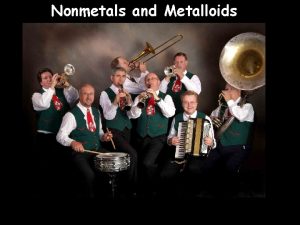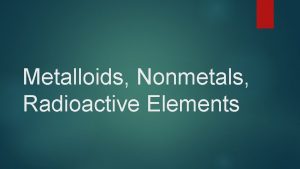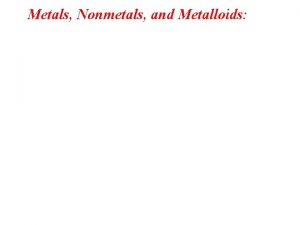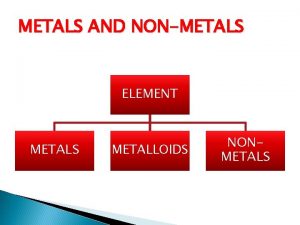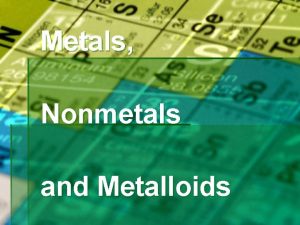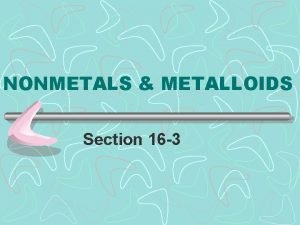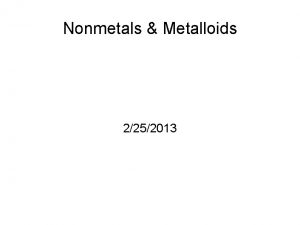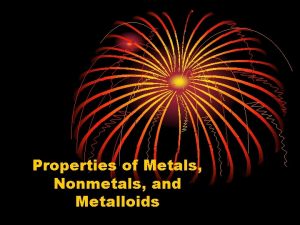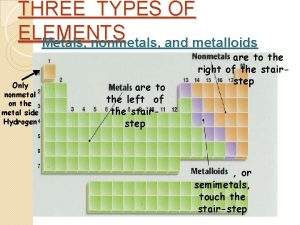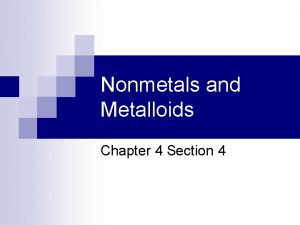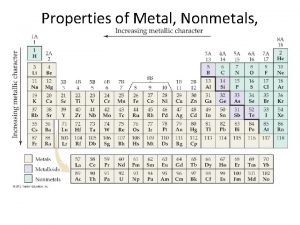Elements and Their Properties Nonmetals and Metalloids Examples
















- Slides: 16

Elements and Their Properties Nonmetals and Metalloids


Examples of Nonmetals may be solids, liquids or gases. Examples: • Solids – Carbon, Sulfur, Phosphorus • Liquid – Bromine • Gases – Oxygen, Hydrogen, Nitrogen

Physical Properties of Nonmetals • Nonmetals have a dull luster. Example: Phosphorus

Physical Properties of Nonmetals • Nonmetals are insulators • They do not conduct electricity or heat well. The atoms in nonmetals do not have loose electrons. Therefore, when electricity, or something hot touches a non-metal, the energy does not move quickly through the material. What would you rather stir a hot pot with—a wooden spoon or a metal spoon?

Physical Properties of Nonmetals • Nonmetals are soft (except for diamonds) and brittle Example: Sulfur

METALLOIDS

Metalloids Physical properties of both metals and non-metals • Some are shiny, some are dull • Somewhat malleable and ductile • Can conduct heat and electricity at a lesser level than metals – known as semiconductors BORON SILICON ARSENIC

Boron Group: Group 13 • have 3 valence electrons • aluminum is the most abundant metal in the earth’s crust • boron is used to make lab glassware 11

Carbon Group: Group 14 • 4 valence electrons • most compounds in your body contain carbon • Silicon is the 2 nd most abundant metal in the earth’s crust 12

• Nitrogen Group: Group 15 • 5 valence electrons • Nitrogen makes up 78% of the air • Phosphorus is in soaps • Arsenic is a well known poison 14

• Oxygen Group: Group 16 • 6 valence e- ’s • Oxygen makes up 21% of the air and is necessary for things to burn 15

GROUP 17: HALOGENS • 7 valence electrons • Highly reactive nonmetals • Fl is the most reactive • Ex: Iodine is important for your thyroid gland 16

GROUP 18: NOBLE GASES • 8 valence e- ’s (except Helium) • Full outer shell of electrons • All are gases • extremely non-reactive (inert) and found in the atmosphere • “Neon” lights contain a variety of Noble Gases 17

18

Review 1. ____ are columns in the periodic table and there ______ total. 2. _______ are located on the left side of the periodic table and are known for being good conductors. 3. ______ is considered to be the “big daddy” on the periodic table because it is the most reactive element. 4. _____ symbols do not occur naturally in nature. 5. _________ are located between groups 6. 3 -12 and when they form compounds make distinctive colors (ex. Stain glass windows). 7. _____ group is considered to be the least reactive group in the periodic table. 8. Give 2 characteristics of nonmetals.
 Metals vs nonmetals
Metals vs nonmetals Chapter 17 section 3 mixed groups
Chapter 17 section 3 mixed groups Metals on periodic table
Metals on periodic table Periodic table metals nonmetals and metalloids
Periodic table metals nonmetals and metalloids Metals vs nonmetals periodic table
Metals vs nonmetals periodic table Metals nonmetals and metalloids answer key
Metals nonmetals and metalloids answer key Metals vs nonmetals vs metalloids
Metals vs nonmetals vs metalloids Differentiate metals nonmetals and metalloids
Differentiate metals nonmetals and metalloids Non metals that can conduct electricity
Non metals that can conduct electricity Properties of metals nonmetals and semimetals
Properties of metals nonmetals and semimetals Metals vs nonmetals properties
Metals vs nonmetals properties Periodic table divided in metals nonmetals and metalloids
Periodic table divided in metals nonmetals and metalloids Poem about metals nonmetals and metalloids
Poem about metals nonmetals and metalloids Periodic table metals nonmetals metalloids noble gases
Periodic table metals nonmetals metalloids noble gases Periodic table metals nonmetals metalloids
Periodic table metals nonmetals metalloids Which list of elements contains two metalloids
Which list of elements contains two metalloids Which list of elements contains two metalloids
Which list of elements contains two metalloids

